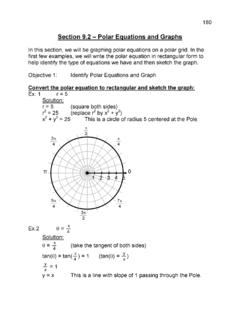Transcription of Equations for Planetary Ellipses - IJSRP
1 International Journal of Scientific and Research Publications, Volume 6, Issue 5, May 2016 160 ISSN 2250-3153 Equations for Planetary Ellipses Eric Sullivan* * Pittsford Mendon High School, Student, Class of 2016 Abstract- Planetary orbits are Ellipses with the sun at one of the foci. The semi major axis of each Planetary orbital was used in part with each planets eccentricity to calculate the semi minor axis and the location of the foci. Equations in standard ellipse form were created for each of the planets. In the first model, the sun is placed at (0,0).
2 With this set-up, the Equations can be completely derived. Once the Equations have been derived, the location of the sun was shifted to the positive (c,0) value. The distances for perihelion and aphelion were calculated by an adapted version of the standard distance equation. After this the accepted value for perihelion and aphelion for each planet was compared to the value measured. The percent error was then calculated. Index Terms- Aphelion, eccentricity, ellipse Equations , perihelion, Planetary orbits I. INTRODUCTION lanetary orbits and how the planets move is useful information to predict certain astronomical events.
3 The orbits of the eight major planets are Ellipses where the sun is located at one of the foci. Each Planetary orbit is slightly greater than the preceding orbit, making it so they can never intersect or collide. During the course of this research, the data was converted from kilometers into gigameters. Light-years, parsecs or astronomical units were not used since they were either too large or too small. A gigameter is equivalent a million kilometers thus making the data much easier to work with.
4 II. IDENTIFY, RESEARCH AND COLLECT IDEA The idea of creating Planetary orbital Equations came about during a math lecture on Ellipses and conical Equations . The information about eccentricity and the semi major axis brought the idea about. A google search revealed no examples of Equations related to Planetary orbitals. But upon a quick conversation with a math professor and a quick glance through my math textbook made me realize that deriving such Equations was possible. All of the values present are measured in gigameters.
5 The use of gigameters was out of convenience because the astronomical unit, light-year, parsec and kilometers were rather large. III. WRITE DOWN YOUR STUDIES AND FINDINGS All of the values present are measured in gigameters. The use of gigameters was out of convenience because the astronomical unit, light-year, parsec and kilometers were rather large. The standard form of an ellipse with the major axis horizontal can be defined as, ( )2 2+( )2 2=1 (1) All of the eight planets have orbits with a horizontal major axis, therefore their Equations will be written in the form of equation 1.
6 The values for the semi major axis are located in table 1. The semi major axis extends from the center of the ellipse to the farthest point on one side. Both of these sides, the (-a,0) and (a,0), together make up the major axis. Thus, the major axis can be recorded as the distance between (-a,0) and (a,0). The value for the semi major axis is always greater than the value for the semi minor axis. Therefore, the location of the semi major axis value (denoted as a) corresponds with the direction of the major axis. For all Planetary Ellipses the a value is located under the x term, meaning that the major axis is horizontal.
7 The values for the eccentricity of a planet s ellipse are recorded in table 1 below. The eccentricity and the semi major axis values allows the value for the location of the foci to be calculated. Any ellipse has an eccentricity value less than one. If the value for eccentricity is equal to one, the result is a parabola. Lastly, if the eccentricity is greater than one, the outcome is a hyperbola. Eccentricity is calculated by dividing the distance from the center to a foci by the semi major axis. With both the eccentricity and semi major axis already recorded, the eccentricity equation can be re-arranged to solve for the c value.
8 The c value is the distance from the center of the ellipse to both of the foci. The re-arranged equation allows for the c value for each Planetary ellipse to be calculated. These values are located in table 1. Now with the a and c values calculated, a simple calculation will produce the b value. The b value is the semi minor axis. The calculated values for b can be found in table 1. The Equations for each planet s orbit can now be written because both the a and b terms have values. P International Journal of Scientific and Research Publications, Volume 6, Issue 5, May 2016 161 ISSN 2250-3153 It must also be noted that all the values in table 1 have been calculated with respect to the sun being located at (0,0).
9 Once the Equations have been written, the sun can be shifted to its respective point at the positive foci with coordinates (c,0). This does not change the center of the ellipse however. Therefore, the model states the center of all Planetary Ellipses is not the sun but another point in space that is located at the true (0,0) location. Respectively, both the a and b values can be filled into their appropriate spots in the general equation for an ellipse as noted by equation 1. The values for h and k in this case are both 0.
10 In table 2, all the Equations are recorded in order of the planet s distance from the sun. By using these Equations and moving the sun back to its corresponding c value for each planet, the values for aphelion and perihelion were measured. These measured values from the graphs of these Equations were then compared to the accepted values. Mercury s equation is , Venus equation is , Earth s equation is and Mars equation is For the outer planets; equation is Jupiter, equation is Saturn, equation is Uranus and equation is Neptune.
















